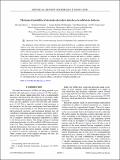| dc.contributor.author | Bucci, Giovanna | |
| dc.contributor.author | Talamini, Brandon Louis | |
| dc.contributor.author | Renuka Balakrishna, Ananya | |
| dc.contributor.author | Chiang, Yet-Ming | |
| dc.contributor.author | Carter, W Craig | |
| dc.date.accessioned | 2018-11-02T19:03:36Z | |
| dc.date.available | 2018-11-02T19:03:36Z | |
| dc.date.issued | 2018-10 | |
| dc.date.submitted | 2018-07 | |
| dc.identifier.issn | 2475-9953 | |
| dc.identifier.uri | http://hdl.handle.net/1721.1/118851 | |
| dc.description.abstract | The interfacial contact between active material and solid electrolyte in a composite electrode limits the kinetics of all-solid-state batteries (ASSB). Despite the progress in processing techniques to improve cohesion in composite electrodes, the electrochemical reactions and mechanical stresses developed during battery operation affects interface properties. Here, we propose a one-dimensional radially symmetric analytical model based on the cohesive theory of fracture, to investigate the mechanical stability of interfaces in ASSB microstructures. Using the cohesive-energy approach, we analyze the delamination criterion and derive a stability condition for fracture propagation. Furthermore, we investigate the role of particle size and material properties on delamination, and we explore the effect of delamination on area-specific impedance. We report that delamination is induced when electrode particles undergo a volumetric change of about 7.5% during (de)intercalation. Compliant electrolytes (E<25GPa) are found to accommodate up to 25% of particle volume change and delay the onset of delamination. The study identifies geometric regimes for mechanical stability. Such regimes are based on the relative size of the damage zone with respect to the particle radius. Finally, we demonstrate that delamination can significantly influence the total charge/discharge time if highly conductive electrolytes are employed. Overall, the analyses provide guidelines for engineering electrode-electrolyte interfacial properties by controlling particle size, material stiffness, and adhesive strength and length scale. | en_US |
| dc.description.sponsorship | United States. Department of Energy (Grant DE-SC0002633) | en_US |
| dc.publisher | American Physical Society | en_US |
| dc.relation.isversionof | http://dx.doi.org/10.1103/PhysRevMaterials.2.105407 | en_US |
| dc.rights | Article is made available in accordance with the publisher's policy and may be subject to US copyright law. Please refer to the publisher's site for terms of use. | en_US |
| dc.source | American Physical Society | en_US |
| dc.title | Mechanical instability of electrode-electrolyte interfaces in solid-state batteries | en_US |
| dc.type | Article | en_US |
| dc.identifier.citation | Bucci, Giovanna et al. "Mechanical instability of electrode-electrolyte interfaces in solid-state batteries." Physical Review Materials 2, 10 (October 2018): 105407 © 2018 American Physical Society | en_US |
| dc.contributor.department | Massachusetts Institute of Technology. Department of Materials Science and Engineering | en_US |
| dc.contributor.department | Massachusetts Institute of Technology. Department of Mechanical Engineering | en_US |
| dc.contributor.mitauthor | Bucci, Giovanna | |
| dc.contributor.mitauthor | Talamini, Brandon Louis | |
| dc.contributor.mitauthor | Renuka Balakrishna, Ananya | |
| dc.contributor.mitauthor | Chiang, Yet-Ming | |
| dc.contributor.mitauthor | Carter, W Craig | |
| dc.relation.journal | Physical Review Materials | en_US |
| dc.eprint.version | Final published version | en_US |
| dc.type.uri | http://purl.org/eprint/type/JournalArticle | en_US |
| eprint.status | http://purl.org/eprint/status/PeerReviewed | en_US |
| dc.date.updated | 2018-10-30T18:00:35Z | |
| dc.language.rfc3066 | en | |
| dc.rights.holder | American Physical Society | |
| dspace.orderedauthors | Bucci, Giovanna; Talamini, Brandon; Renuka Balakrishna, Ananya; Chiang, Yet-Ming; Carter, W. Craig | en_US |
| dspace.embargo.terms | N | en_US |
| dc.identifier.orcid | https://orcid.org/0000-0002-9449-3728 | |
| dc.identifier.orcid | https://orcid.org/0000-0002-0833-7674 | |
| dc.identifier.orcid | https://orcid.org/0000-0001-7564-7173 | |
| mit.license | PUBLISHER_POLICY | en_US |
